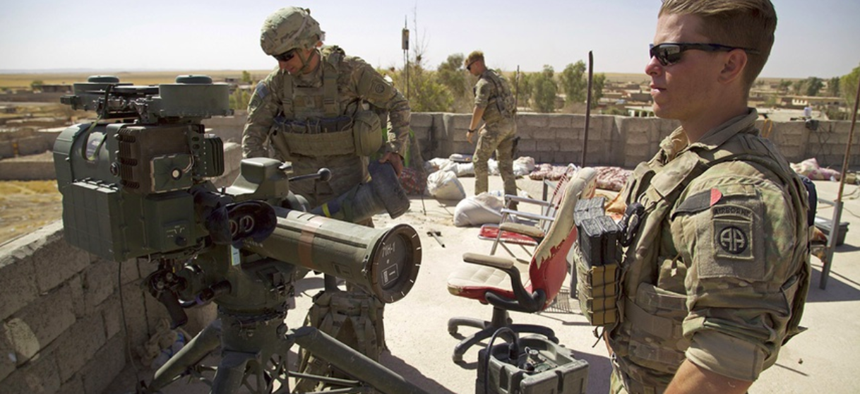
U.S. Army soldiers stands next to a a guided-missile launcher, a few miles from the frontline, in the village of Abu Ghaddur, east of Tal Afar, Iraq, Sunday, Aug. 20, 2017. AP PHOTO/BALINT SZLANKO
Army Developing Simulated Missile Launchers to Improve Combat Training
The goal is to train pilots and other crew members on how to respond to shoulder-fired missiles and rocket launchers.
The U.S. Army is taking a virtual approach to improve pilot training and air defense artillery training against shoulder-fired missiles and rocket launchers.
Last week, the Army inked a $500,000 contract with Orlando, Florida-based Cole Engineering Services to develop a prototype physical device soldiers will carry during training that simulates a shoulder-fired missile.
The devices will provide “real-time orientation and positioning status to support simulated engagements during live exercises at the Army Combat Training Centers,” according to the company, and will essentially turn this form of combat training into a video game.
“The device will interface through a network, providing its location and orientation on the training battlefield. When the soldier engages the aircraft with it, it will transmit that information to the database, which will also be tracking the aircraft flying in the air,” said Tim Greeff, the chief executive officer of Arlington, Va.-based National Security Technology Accelerator, or NSTXL.
The device is expected to improve how pilots and associated personnel respond and react to shoulder-fire missile threats, and will provide real-time performance data points, such as casualty assessments.
NSTXL is a consortium that manages the Army’s Training and Readiness Accelerator solicitations and will assist Cole Engineering Services as it develops the prototype to completion. The contract was awarded through an other transaction authority, a contracting method that allows the Defense Department and other select agencies to rapidly acquire emerging and prototype technologies.
Once Cole Engineering Services delivers the prototype device, the Army will review it and could choose to develop additional units and deploy them across the military branch.
“This is a vital project for the Army and we are honored to be selected by the service,” said John R. “Buck” Surdu, project manager for Cole Engineering Services, in a statement. “We are confident that our solution will boost training and improve the ability of the Army to combat enemy threats, and we are excited to be able to pioneer next-generation capabilities during this effort.”
